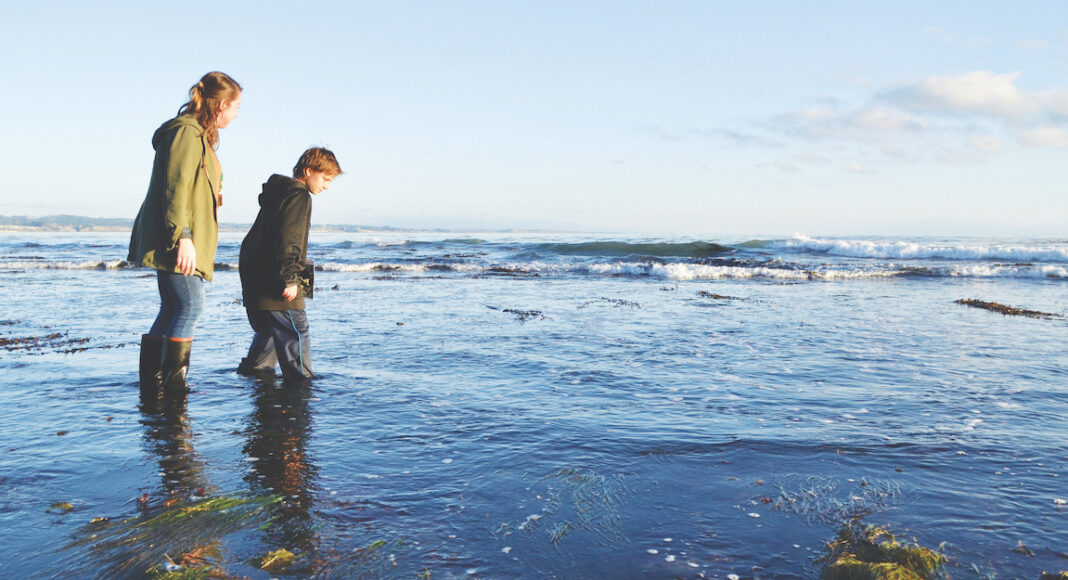For more than 116 years, the Santa Cruz Museum of Natural History (SMNH) has aimed to connect residents and visitors alike to the natural world—from the deep waters of the Monterey Bay to the high ranges of the Santa Cruz Mountains.
The museum was originally established in 1904 by naturalist Laura Hecox, daughter of original Santa Cruz lighthouse keepers Adna and Margaret Hecox. Fascinated by nature from a young age, Laura had gathered an extensive personal collection of seashells, minerals, fossils, Native American artifacts and more that was eventually willed to the City of Santa Cruz for the establishment of its first public museum.
“We are always doing whatever we can to honor Laura’s legacy,” says Kiersten Elzy-Loving, development and community partnership manager who has been a museum member since 1989. “Her spirit still lives on.”
Like many museums in Santa Cruz County, SMNH is a nonprofit, run entirely by a small staff of educators, scientists and naturalists to build curriculum, curate exhibits and plan events.
“The team here is remarkable,” says Elzy-Loving. “There is not a person who works here who isn’t deeply committed to the work and our mission.”
When the pandemic hit last year, SMNH was forced to close its doors, halt field trips and all other programs. But the team was quick to adapt—creating virtual opportunities to engage online visitors. They launched “Museum at Your Side” in 2020, taking different pieces of the museum and making it accessible to students and families.
The online presence not only reached students and teachers during their year of distance learning, but also people of all ages who had not connected with the museum before.
“We recognized that it created a new capacity,” Elzy-Loving says. “People who can’t come to events and programs, even when we’re open, because of distance, physical limitations, transportation … they can now engage with us.”
As it surfaces from the pandemic, SMNH has joined Santa Cruz Gives (SCG), a holiday fundraising campaign aiming to create a local network of donors and increase giving via crowdsourcing. This year the campaign doubled in size, highlighting a total of 80 local nonprofits. Donors can visit santacruzgives.org, where each organization has a profile page detailing their story and how they will use the money.
With the funds raised, the museum hopes to expand Museum at Your Side offerings in the new year. They also hope to strengthen their connections with other local organizations.
“Fiscally, [Santa Cruz Gives] is wonderful, but I think the better understanding of the landscape of other local nonprofits is also a tremendous opportunity,” Elzy-Loving says.
Another environmental-based organization participating in the campaign is Save Our Shores (SOS). The small nonprofit aims to conserve marine life and habitats in the Monterey Bay through policy changes, educational programs, beach cleanups and more. Like SMNH, the group has spent the last year playing catch-up.
“We’re trying to dig ourselves out of the financial impacts of the pandemic,” says SOS’ executive director Erica Donnelly-Greenan. “We are trying to rebuild our staff, volunteer base and programs. It’s a chicken and egg situation: We need the resources to build, but we also need to keep our programs and grants going, making sure our donors and supporters know that we’re still making an impact.”
Through SCG fundraising, SOS hopes to bring back and strengthen its learning programs to help educators meet changing science education standards. They once again are offering field trips to state parks, rivers and parks.
“Nature is the best classroom,” Donnelly-Greenan says. “It truly fosters that connection and helps them figure out the bigger picture. How we’re all tied together.”
Donnelly-Greenan, who only recently took over the position of executive director, says she has big plans to revamp how the organization connects with the community. This includes focusing on communities that need it the most, and addressing environmental injustice to assist those who have limited resources.
“We’re still going to do our beach cleanups, but we’re trying to get people to understand that clean beaches are the byproduct of the work we’re all doing together,” she says.
In South County, Watsonville Wetlands Watch (WWW) has restarted its in-person field trips and programs for local youth.
“We’re doing great,” says WWW executive director Jonathan Pilch. “It’s been a challenging year in a lot of ways, but also inspiring. We’re working on expanding our education programs to provide more outdoor learning for more students, and inspire more local youth to see themselves as the future leaders, scientists, and change-makers so needed for our community and planet.”
WWW does this through watershed restoration projects, job training, internships, and educational programs for 3rd-12th graders in the Pajaro Valley. With money raised through SCG, they aim to offer students more hands-on opportunities to reconnect with nature, as well as enhance public access to wetlands and host more tree plantings to reduce the impacts of climate change and improve air quality.
“It’s a really exciting time for our programs right now,” Pilch says.
Learn more and donate to these and other local environmental-based nonprofits at santacruzgives.org.













